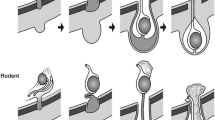Summary
Nerve growth factor (NGF) affects morphology and function of isolated and cultured seminiferous tubules from human testis. Quanitative determination of this neurotrophic protein revealed an amount of 5.4 ng per g human testis, suggesting a crucial function of NGF in spermatogenic tissue. With the use of immunohistochemical methods target cells for NGF were identified within the lamina propria. NGF receptors were also visualized on sympathetic nerve fibers crossing the interstitial compartment among adjacent tubules and spatially correlated blood vessels. NGF receptors could be demonstrated on isolated lamina-propria cells even after 2 weeks of culture. Most of the NGF receptor-bearing cells differed from myoid cells of the lamina propria expressing desmin, a marker for smooth muscle. However, some NGF receptor-expressing cells were found sharing morphological and structural similarities with myoid cells. The present data indicate the existence of a NGF-responsive lamina-propria cell that influences the tubular wall and also the seminiferous epithelium.
Similar content being viewed by others
References
Aumüller G, Steinbrück M, Krause W, Wagner HJ (1988) Distribution of vimentin-type intermediate filaments in Sertoli cells of the human testis, normal and pathologic. Anat Embryol 178:129–136
Ayer-LeLievre C, Olson L, Ebendal T, Hallböök F, Persson H (1988) Nerve growth factor mRNA and protein in the testis and epididymis of mouse and rat. Proc Natl Acad Sci USA 85:2628–2632
Banerjee SP, Snyder SH, Cuatrecasas P, Greene LA (1973) Nerve growth factor receptor binding in sympathetic ganglia. Proc Natl Acad Sci USA 70:2519–2528
Baumgarten HG, Holstein AF (1967) Catecholaminhaltige Nervenfasern im Hoden des Menschen. Z Zellforsch 79:389–395
Baumgarten HG, Holstein AF (1968) Adrenerge Innervation im Hoden und Nebenhoden vom Schwan (Cygnus olor). Z Zellforsch 91:402–410
Baumgarten HG, Holstein AF (1971) Noradrenerge Nervenfasernim Hoden von Mammaliern und anderen Vertebraten. J Neuro-Visceral Rel [Suppl] X:563–572
Fawcett DW (1975) Ultrastructure and function of the Sertoli cell. In: Hamilton DW, Greep RO (eds) Handbook of physiology. Endocrinology: Male reproductive system. Williams and Wilkins, Baltimore MD, Vol 5, Sect 7, pp 21–55
Grobstein C (1967) Mechanism of organogenetic tissue interaction. Natl Cancer Inst Monogr 26:279–299
Hadley MA, Dym M (1987) Immunocytochemistry of extracellular matrix in the lamina propria of the rat testis: Electron microscopic localization. Biol Reprod 37:1283–1289
Hadley MA, Byers SW, Suarez-Quian CA, Kleinman HK, Dym M (1985) Extracellular matrix regulates Sertoli cell differentiation, testicular cord formation, and germ cell development in vitro. J Cell Biol 101:1511–1522
Herrup K, Shooter EM (1973) Properties of the β-nerve growth factor receptor of avian dorsal root ganglia. Proc Natl Acad Sci USA 70:3884–3888
Heumann R, Korsching S, Scott J, Thoenen H (1984) Relationship between levels of nerve growth factor (NGF) and its messenger RNA in sympathetic ganglia and peripheral target tissues. EMBO J 3:3183–3189
Hutson JC, Stocco DM (1981) Peritubular cell influence on the efficiency of androgen-binding protein secretion by Sertoli cells in culture. Endocrinology 108:1326–1368
Korsching S, Thoenen H (1983) Nerve growth factor in sympathetic ganglia and corresponding target organs in the rat: Correlation with density of sympathetic innervation. Proc Natl Acad Sci USA 68:3513–3516
Kuntz A (1919) The innervation of the gonads in the dog. Anat Rec 17:203–219
Levi-Montalcini R, Angeletti PU (1968) Nerve growth factor. Physiol Rev 48:534–569
Neely MD, Boekelheide K (1988) Sertoli cell processes have axoplasmic features: An ordered microtubule distribution and abundant high molecular weight microtubule-associated protein (cytoplasmic dynein). J Cell Biol 107:1767–1776
Olson L, Ayer-Lelievre C, Ebendahl T, Steiger A (1987) Nerve growth factor-like immunoreactivities in rodent salivary glands and testis. Cell Tissue Res 248:275–286
Ross AH, Grob P, Bothwell M, Elder DE, Ernst CS, Marano NM, Ghrist BFD, Slemp CC, Herlyn M, Atkinson B, Koprowski H (1984) Characterization of nerve growth factor receptor in neural crest tumors using monoclonal antibodies. Proc Natl Acad Sci USA 81:6681–6685
Russell LD, Tallon-Doran M, Weber JE, Wong V, Peterson RN (1983) Three-dimensional reconstruction of a rat stage V Sertoli cell: III. A study of specific cellular relationships. Am J Anat 167:181–192
Seidl K, Holstein AF (1990) Organ culture of human seminiferous tubules: A useful tool to study the role of nerve growth factor in the testis. Cell Tissue Res 261:539–547
Skinner MK, Fritz IB (1985) Testicular peritubular cells secrete a protein under androgen control that modulates Sertoli cell functions. Proc Natl Acad Sci USA 82:114–118
Skinner MK, Fritz IB (1986) Identification of a non-mitotic paracrine factor involved in mesenchymal-epithelial cell interactions between testicular peritubular cells and Sertoli cells. Mol Cell Endocrinol 44:85–97
Skinner MK, Tung PS, Fritz IB (1985) Cooperativity between Sertoli cells and testicular peritubular cells in the production and deposition of extracellular matrix components. J Cell Biol 100:1941–1947
Thoenen H, Barde Y-A (1980) Physiology of nerve growth factor. Physiol Rev 60:1284–1335
Tung PS, Fritz IB (1980) Interactions of Sertoli cells with myoid cells in vitro. Biol Reprod 23:207–217
Varon S, Adler R (1981) Trophic and specifying factors directed to neuronal cells. Advanc Cell Neurobiol 2:115–163
Vogl AW, Lin YC, Dym M, Fawcett DW (1983a) Sertoli cells of the golden-mantled ground squirrel (Spermophilus lateralis): A model system for the study of shape change. Am J Anat 168:83–98
Vogl AW, Linck RW, Dym M (1983b) Colchicine-induced changes in the cytoskeleton of the golden-mantled ground squirrel (Spermophilus lateralis) Sertoli cells. Am J Anat 168:99–108
Weber JE, Russell LD, Wong V, Peterson RN (1983) Three-dimensional reconstruction of a rat stage V Sertoli cell: II. Morphometry of Sertoli-Sertoli and Sertoli-germ cell-relationships. Am J Anat 167:163–179
Wong V, Russell LD (1983) Three-dimensional reconstruction of a rat stage V Sertoli cell: I. Methods, Basic configuration, and dimensions. Am J Anat 167:143–161
Zimmermann A, Sutter A (1983) β-Nerve growth factor (βNGF) receptor on glial cell. Cell-cell interaction between neurons and Schwann cells in cultures of chick sensory ganglia. EMBO J 2:879–885
Author information
Authors and Affiliations
Rights and permissions
About this article
Cite this article
Seidl, K., Holstein, AF. Evidence for the presence of nerve growth factor (NGF) and NGF receptors in human testis. Cell Tissue Res 261, 549–554 (1990). https://doi.org/10.1007/BF00313534
Accepted:
Issue Date:
DOI: https://doi.org/10.1007/BF00313534




